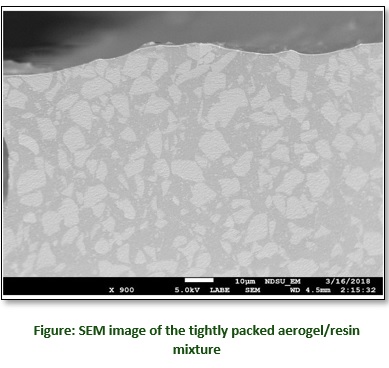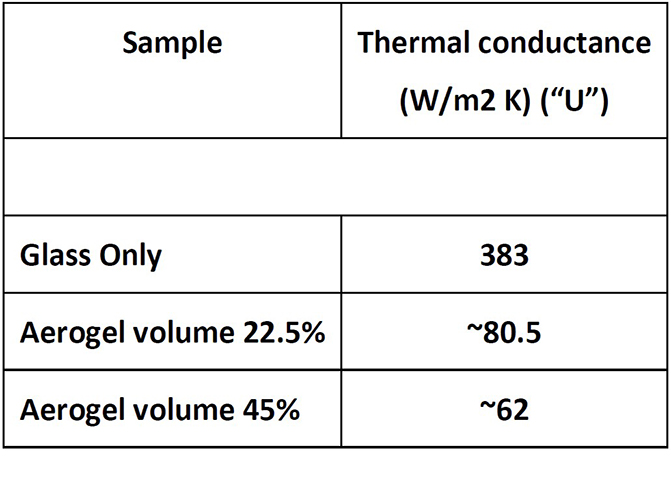Improved Temperature and Sound Insulation by Coating with Tightly Packed Aerogel/Resin Mixtures (RFT-590)
Summary
 Researchers at NDSU have developed a method to produce aerogel coatings that provide thermal insulation and sound dampening. Aerogel, a super-insulating and durable material, is widely considered to be the lightest and best insulating product in the world. However, it is also very brittle, losing effectiveness when broken. The NDSU team has developed a process for making an aerogel-containing resin that enables extremely tight packing of the aerogel (the image below shows 45% aerogel by volume, at 900x magnification). By including so much aerogel, the resin mixture becomes a very effective insulator, as well as a sound dampening layer. The resin component surrounds, supports and protects the fragile aerogel particles, increasing their durability and versatility. The technology can potentially be used to develop coatings for situations where thermal and sound barriers are desired. This has been demonstrated on glass, where thermal insulation was increased by about 80%. Details of the testing on glass are provided below, representing an example of the possibilities, and an approximation of the performance that may be seen in other applications.
Researchers at NDSU have developed a method to produce aerogel coatings that provide thermal insulation and sound dampening. Aerogel, a super-insulating and durable material, is widely considered to be the lightest and best insulating product in the world. However, it is also very brittle, losing effectiveness when broken. The NDSU team has developed a process for making an aerogel-containing resin that enables extremely tight packing of the aerogel (the image below shows 45% aerogel by volume, at 900x magnification). By including so much aerogel, the resin mixture becomes a very effective insulator, as well as a sound dampening layer. The resin component surrounds, supports and protects the fragile aerogel particles, increasing their durability and versatility. The technology can potentially be used to develop coatings for situations where thermal and sound barriers are desired. This has been demonstrated on glass, where thermal insulation was increased by about 80%. Details of the testing on glass are provided below, representing an example of the possibilities, and an approximation of the performance that may be seen in other applications.
The table shows that the heat loss/gain through a glass can be substantially reduced by applying the aerogel resin. This is based on the equation Q = U * A * {Delta}T
 Where Q is the total amount of heat transferred through a glass, U is thermal conductance, A is area of the glass surface and delta T is the temperature difference between indoor and outdoor temperature. Through application of the new product, the lower modified U factor will provide a major improvement of the building overall heating and cooling loads.
Where Q is the total amount of heat transferred through a glass, U is thermal conductance, A is area of the glass surface and delta T is the temperature difference between indoor and outdoor temperature. Through application of the new product, the lower modified U factor will provide a major improvement of the building overall heating and cooling loads.
Benefits
- Improve energy efficiency of older buildings without needing to replace old windows
- Resin coats a single pane of glass, rather than needing to be introduced and held between glass panes
- Greatly reduce condensation on interior glass during cold weather, lessening the potential for water damage on the window frames and sill
- High visibility, so excellent for "daylighting" situations

Phase of Development
This technology has successfully completed laboratory testing with reproducible results.
Patents
This technology is patent pending in the US (US 2021/0347990) and is available for licensing/partnering opportunities.
Contact
NDSU Research Foundation
info(at)ndsurf(dot)org
(701)231-8173
NDSURF Tech Key
RFT, 590, RFT590
Inquire about this technology >